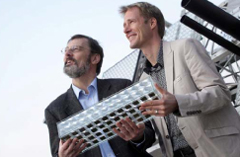
| Home | About Us | Contribute | Bookstore | Advertising | Subscribe for Free NOW! |
| News Archive | Features | Events | Recruitment | Directory |
News
15 June 2010
ISE researchers win Fraunhofer Prize for recordefficiency
multi-junction solar cells and CPV modules
 In late May, it was announced that Drs Andreas Bett and Frank Dimroth — heads of the Department of Materials (Solar Cells and Technologies) and the III-V – Epitaxy and Solar Cells group, respectively, at the Fraunhofer Institute for Solar Energy Systems ISE in Freiburg, Germany had received the Fraunhofer Gesellschaft’s highest distinction — the €20,000 Joseph von Fraunhofer Prize for 2010 — for achieving record solar cell conversion efficiency of 41.1% last year. Since 1978, the Fraunhofer Gesellschaft has awarded staff annual prizes for outstanding scientific accomplishments that solve applications-based problems.
In late May, it was announced that Drs Andreas Bett and Frank Dimroth — heads of the Department of Materials (Solar Cells and Technologies) and the III-V – Epitaxy and Solar Cells group, respectively, at the Fraunhofer Institute for Solar Energy Systems ISE in Freiburg, Germany had received the Fraunhofer Gesellschaft’s highest distinction — the €20,000 Joseph von Fraunhofer Prize for 2010 — for achieving record solar cell conversion efficiency of 41.1% last year. Since 1978, the Fraunhofer Gesellschaft has awarded staff annual prizes for outstanding scientific accomplishments that solve applications-based problems.
Picture: Bett (left) and Dimroth (right).
In ISE’s record metamorphic triplejunction cell reported last year, three subcells of gallium indium phosphide (GaInP), gallium indium arsenide (GaInAs) and germanium (Ge) are deposited by MOCVD in a stacked on top of each other. Each absorbs different wavelength ranges of the solar spectrum, boosting energy conversion efficiency. Fresnel lenses at a distance of about 10cm focus incident sunlight onto the 3mm 2 cells, concentrating it by a factor of 500. The technology produces more power per area than conventional flat-plate PV technology, reducing the area of semiconductor needed. “We substitute costly semiconductor material with inexpensive optics,” says Bett. The record conversion efficiency of 41.1% is nearly double the efficiency of conventional silicon-based solar cells.
ISE’s multi-junction cell technology has been implemented in concentrator modules that have been commercialized with spin-off firm Concentrix Solar GmbH under the brand name FLATCON. Concentrix now has more than 60 staff and ships modules mainly to the USA and southern Europe, including systems feeding more than 600kW into the grid at a solar park in Spain. Currently, the AC efficiency of a complete 5kW system is 25%.
Due to the concentrating optics, the systems make use of only direct solar radiation and hence must track the sun. However, due to the two-axis tracking mechanism, high power output can be achieved even in the morning and evening hours. Also, since radiation scattered by clouds or water droplets cannot be concentrated, such systems are not particularly suitable in countries like Germany or as roof-top systems, but rather as large commercial power stations in sunny countries having a large fraction of direct radiation, e.g. in southern Europe.
Using ISE’s latest metamorphic triple-junction solar cell technology gives systems with 29% efficiency. Using efficient cells also reduces the cost of solar electricity, says Bett. Under favourable conditions, electricity costs of just 10–15 cents per kilowatt are possible for southern Europe. “Systems have the potential to supply southern Europe with low-cost solar electricity in a matter of just a few years,” reckons Dimroth.
“Mass production reduces costs,” says Dimroth. “In the long-term, we calculate that this technology will be about 20–30% more economical than silicon technology.” A team of 50 at ISE is hence working to optimize aspects of the system, i.e. from the cell through the measurement technology and process technology up to the modules. An advantage of CPV systems is their modular construction, which allows them to be expanded arbitrarily to kilowatt or even gigawatt size. Also, the capital needs and investment for building automated series production are comparatively low. In addition, the energy consumption for the manufacture and installation of the CPV systems is amortized within a few months. The aim is to demonstrated that the systems can be made in large numbers at low cost and that they can produce energyreliably over a period of 20 years.
See related items:
Fraunhofer ISE’s Frank Dimroth receives French science prize
Fraunhofer ISE raises multi-junction solar cell efficiency record to 41.1%
![]() Search: Fraunhofer ISE Triple-junction solar cell CPV Germanium substrate MOCVD GaInP GaInAs
Search: Fraunhofer ISE Triple-junction solar cell CPV Germanium substrate MOCVD GaInP GaInAs
Visit: www.fraunhofer.de/en